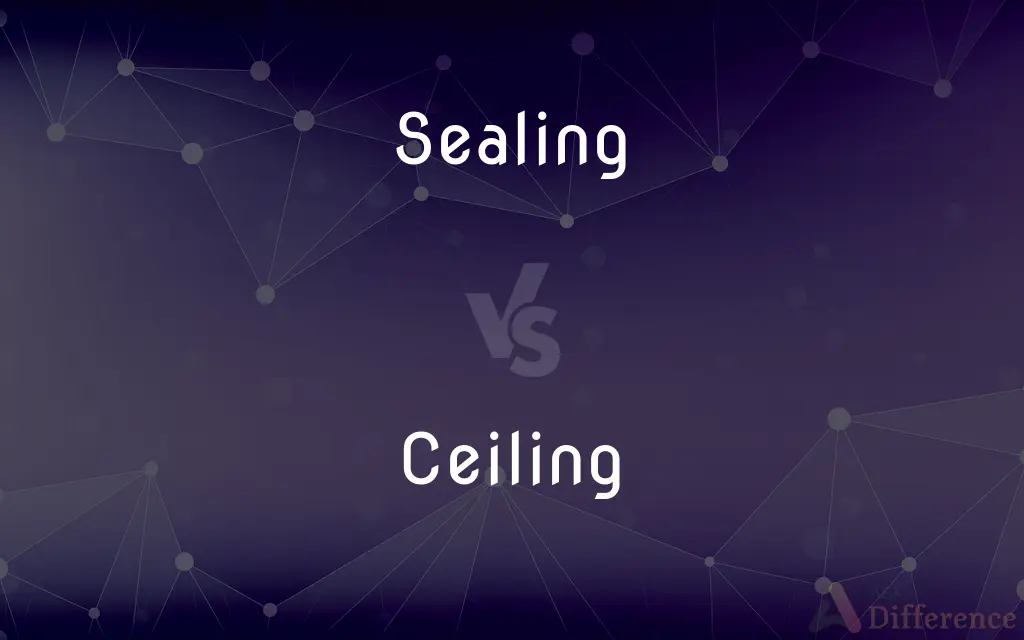Sealing vs. Ceiling — What's the Difference?
Edited by Tayyaba Rehman — By Fiza Rafique — Updated on April 17, 2024
Sealing involves closing or securing something, often used in the context of preventing leaks, whereas ceiling refers to the upper interior surface of a room.

Difference Between Sealing and Ceiling
Table of Contents
ADVERTISEMENT
Key Differences
Sealing is the act of making something airtight or watertight, typically to prevent the passage of air, water, or other substances. On the other hand, a ceiling is the upper surface of a room, often finished with materials like plaster or drywall, which serves both aesthetic and functional purposes.
In terms of purpose, sealing is often a preventative measure used in various contexts like plumbing, construction, and packaging. Meanwhile, a ceiling serves as a key element of architectural design and has important roles such as insulation, soundproofing, and providing a space to conceal electrical wiring and plumbing.
Materials used for sealing include caulks, sealants, gaskets, and tapes designed specifically to fill gaps and joints. Conversely, ceilings are constructed from materials such as plaster, drywall, tiles, and sometimes decorative elements like wood or metal panels.
The process of sealing involves applying a material to gaps or joins between two surfaces to prevent leakage or intrusion. Whereas installing a ceiling involves construction techniques that might include framing, plastering, and painting, depending on the desired finish and features.
Professionals involved in sealing tasks can range from plumbers and mechanics to construction workers, depending on the application. In contrast, ceiling installation is typically carried out by carpenters, drywall installers, and painters.
ADVERTISEMENT
Comparison Chart
Definition
Process of making something airtight or watertight.
Upper interior surface of a room.
Purpose
Prevent leaks and protect against environmental elements.
Enhance room aesthetics and provide insulation.
Materials Used
Caulks, sealants, gaskets.
Plaster, drywall, tiles.
Process Involved
Applying sealant materials to joints or gaps.
Construction of structural surface and finishing.
Professional Fields
Plumbing, construction, automotive.
Construction, interior design.
Compare with Definitions
Sealing
Applying a sealant to prevent passage of liquids or gases.
Sealing the windows reduced drafts and lowered heating costs.
Ceiling
An upper limit set on prices, wages, or expenditures.
The government imposed a ceiling on gasoline prices.
Sealing
The act of closing or fastening an envelope, container, or opening securely.
The sealing of the jar ensured its contents remained fresh.
Ceiling
The maximum altitude that an aircraft can reach.
The fighter jet has a ceiling of 50,000 feet.
Sealing
Making any passage impervious to leaks.
Sealing the cracks in the basement walls prevented flooding.
Ceiling
A limit on the amount of money that can be charged or spent.
The project's budget ceiling was quickly reached.
Sealing
Officially or formally confirming or ratifying something.
The sealing of the agreement took place at noon.
Ceiling
The highest amount or level that can be attained.
The athlete's performance set a new ceiling for the competition.
Sealing
Protecting a surface or seam from water or air by applying a protective coating.
Sealing the deck every year preserves the wood.
Ceiling
The overhead upper surface of a room.
The ceiling of the old church was painted with beautiful frescoes.
Sealing
A device or material that is used to close off or fasten an opening or connection, especially to prevent the escape of a liquid or gas
Used caulk as a seal around the window.
Ceiling
A ceiling is an overhead interior surface that covers the upper limits of a room. It is not generally considered a structural element, but a finished surface concealing the underside of the roof structure or the floor of a story above.
Sealing
An airtight closure
A door that lacks a tight seal.
Ceiling
The upper interior surface of a room or other similar compartment
The books were stacked from floor to ceiling
Sealing
Something, such as a piece of tape, that is placed on a product or package to show that the contents have not been tampered with.
Ceiling
The inside planking of a ship's bottom and sides.
Sealing
The water in the trap of a drain that prevents sewer gas from escaping into a room.
Ceiling
The upper interior surface of a room.
Sealing
A design used to identify a person or thing or to show that something is authentic, accurate, or of good quality
The title page is marked with the publisher's seal. Does the scale have the inspector's seal?.
Ceiling
Material used to cover this surface.
Sealing
A small decorative paper sticker.
Ceiling
Something resembling a ceiling
A ceiling of leaves over the arbor.
Sealing
A die or signet having a raised or incised emblem used to stamp an impression on a receptive substance such as wax or lead.
Ceiling
An upper limit, especially as set by regulation
Wage and price ceilings.
Sealing
The impression so made.
Ceiling
The highest altitude under particular weather conditions from which the ground is still visible.
Sealing
The design or emblem itself, belonging exclusively to the user
A monarch's seal.
Ceiling
The altitude of the lowest layer of clouds.
Sealing
A small disk or wafer of wax, lead, or paper bearing such an imprint and affixed to a document to prove authenticity or to secure it.
Ceiling
The maximum altitude that an aircraft can reach under a given set of conditions, such as a minimum rate of climb.
Sealing
An indication or symbol regarded as guaranteeing or authenticating something
The choral director gave the program his seal of approval.
Ceiling
(Nautical) The planking applied to the interior framework of a ship.
Sealing
Any of various aquatic carnivorous mammals of the families Phocidae and Otariidae, found chiefly in cold regions and having a sleek torpedo-shaped body and limbs that are modified into paddlelike flippers.
Ceiling
The overhead closure of a room.
The dining room had an ornate ceiling.
Sealing
The pelt or fur of one of these animals, especially a fur seal.
Ceiling
The upper limit of an object or action.
Sealing
Leather made from the hide of one of these animals.
Ceiling
(aviation) The highest altitude at which an aircraft can safely maintain flight.
Sealing
To close or fasten with a seal
Seal an envelope.
Seal a test tube.
Ceiling
(meteorology) The measurement of visible distance from ground or sea level to an overcast cloud cover; under a clear sky, the ceiling measurement is identified as "unlimited."
Even though it was cloudy, there was still enough ceiling for the Blue Angels to perform a great show.
Sealing
To prevent (a liquid or gas) from escaping
Charring a piece of meat seals in the juices.
Ceiling
(mathematics) The smallest integer greater than or equal to a given number.
The ceiling of 4.5 is 5; the ceiling of −4.5 is −4.
Sealing
To cover, secure, or fill up (an opening)
Sealed the hole in the pipe with epoxy.
Ceiling
(nautical) The inner planking of a vessel.
Sealing
To apply a waterproof coating to
Seal a blacktop driveway.
Ceiling
(finance) The maximum permitted level in a financial transaction.
Sealing
To secure or prevent passage into and out of (an area). Often used with off
The police sealed off the crime scene.
Ceiling
(architecture) The overhead interior surface that covers the upper limits of a room.
Sealing
To affix a seal to (something) in order to prove authenticity, accuracy, or quality.
Ceiling
The inside lining of a room overhead; the under side of the floor above; the upper surface opposite to the floor.
Sealing
To establish or determine irrevocably
Our fate was sealed.
Ceiling
The inner planking of a vessel.
Sealing
Mormon Church To make (a marriage, for example) eternally binding; solemnize forever.
Ceiling
The overhead upper surface of a room;
He hated painting the ceiling
Sealing
To hunt seals.
Ceiling
(meteorology) altitude of the lowest layer of clouds
Sealing
Used for closing securely.
Ceiling
An upper limit on what is allowed;
They established a cap for prices
Sealing
Present participle of seal
Ceiling
Maximum altitude at which a plane can fly (under specified conditions)
Sealing
Present participle of seal
Sealing
Action of the verb to seal in any sense.
Sealing
Hunting of seals (the animals).
Sealing
The act of treating something to make it repel water
Common Curiosities
What is the main purpose of sealing in construction?
The main purpose of sealing in construction is to prevent water and air infiltration, enhancing building durability and energy efficiency.
Can ceiling designs affect the acoustics of a room?
Yes, ceiling designs can significantly affect room acoustics by influencing sound absorption and reflection.
What are the benefits of sealing windows and doors in a home?
Sealing windows and doors improves energy efficiency in a home.
Are there any environmental benefits to effective sealing in buildings?
Effective sealing reduces energy consumption by minimizing heat loss in winter and heat gain in summer, thus contributing to lower carbon emissions and improved overall energy efficiency.
What types of sealants are commonly used in home repair?
Common sealants include silicone, acrylic, and polyurethane, each suited for different surfaces and purposes.
How does a ceiling contribute to a room's insulation?
A ceiling helps retain heat in a room, provides a barrier against external temperature changes, and can be fitted with insulation materials to improve thermal efficiency.
What is the significance of ceiling height in architectural design?
Ceiling height can influence the perception of space in a room, with higher ceilings often providing a sense of luxury and spaciousness, while also impacting lighting and ventilation.
How often should sealants be replaced to maintain their effectiveness?
Sealants should generally be inspected annually and replaced every 5 to 10 years, depending on the material's quality and environmental conditions.
What types of materials are best for high-ceiling construction?
Materials like reinforced concrete, steel, and engineered wood are suitable for high-ceiling constructions due to their structural integrity and ability to span large distances.
How does the choice of ceiling materials affect maintenance costs?
The choice of ceiling materials can significantly impact maintenance costs; for instance, materials like gypsum boards are inexpensive but may require more frequent repairs and painting, whereas materials like metal panels are more durable but might have higher initial costs.
Share Your Discovery

Previous Comparison
Chlorophyll vs. Chloroplast
Next Comparison
Plasmid vs. CosmidAuthor Spotlight
Written by
Fiza RafiqueFiza Rafique is a skilled content writer at AskDifference.com, where she meticulously refines and enhances written pieces. Drawing from her vast editorial expertise, Fiza ensures clarity, accuracy, and precision in every article. Passionate about language, she continually seeks to elevate the quality of content for readers worldwide.
Edited by
Tayyaba RehmanTayyaba Rehman is a distinguished writer, currently serving as a primary contributor to askdifference.com. As a researcher in semantics and etymology, Tayyaba's passion for the complexity of languages and their distinctions has found a perfect home on the platform. Tayyaba delves into the intricacies of language, distinguishing between commonly confused words and phrases, thereby providing clarity for readers worldwide.
















































